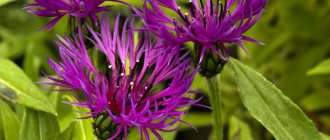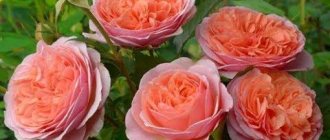General description of coral peonies
All coral species are hybrids, most of them created by American and Canadian breeders. The era of coral began in the middle of the 20th century, the best types were created by Sam Wissing, Arthur Sanders from the USA. Hybrid peonies in coral tones have strong peduncles, a lush bush with bright green, bluish foliage. By autumn the bush turns yellow or red. The flowers are densely or slightly double, sometimes simple in appearance.
The difference between coral hybrids is the gradual change in color of the petals. The bud, bright at the beginning of flowering, becomes discolored over time, the coral range is replaced by apricot, sand, beige, and yellowish shades. Many hybrids cannot maintain rich color.
Hybrids are resistant to diseases, heat and frost, and resist fungal infections better than many varieties. The bush does not crumble, does not require garter, large flowers do not bend to the ground. During the season, many shoots with buds grow, the flowers bloom gradually, providing a long flowering period.
Help: to preserve bright colors, it is recommended to plant coral varieties in places with afternoon shading.
Fertilizer and feeding
For full growth and abundant flowering, peonies need to be periodically fed and fertilized.
The first fertilizing is carried out at the end of April with complex fertilizers (Kemira-universal, rotted manure), which are scattered in the root circle, sprinkled with soil and watered.
For the second feeding (10-14 days after the first) and the third (2-3 weeks after the second), it is ideal to use Kemira-combi, scattering it in the tree trunk and watering it or dissolving it in water.
In early September, when the plant accumulates strength for future flowering, you need to feed the bushes with superphosphate (dissolve 1 tablespoon of double superphosphate or 2 tablespoons of simple superphosphate in 10 liters of water).
Advantages of use in landscape design
Coral peonies look bright in single and group plantings. Powerful bushes and bright greenery refresh the areas, buds of rich colors are noticeable from afar. The coral tone successfully complements the red peonies.
In a group with peony you can plant:
- irises in white, yellow, brown tones;
- low coniferous crops;
- Heuchera;
- lilies;
- primrose.
The coral peony looks great against the background of a grassy lawn.
How to properly care?
Not only sufficient lighting, watering and fertilizing are important for peonies. Being actively developing plants, they need timely staking and rejuvenation. In particular, these procedures are necessary for mature plants whose age exceeds 7-8 years.
Gartering is a procedure often required for peonies during the formation of buds. Many varieties of these perennials produce buds that are too large and flowers that are quite heavy, which can lead to breakage of the flowering stems. It is advisable to garter when the buds have not yet acquired large sizes. For this procedure, a wooden support is usually used, to which the stems are tied with a soft rope.
Often bushes that are too spreading also need a garter. In this case, wooden stakes are stuck into the ground around the plant, on which several rows of soft cord are fixed in a circle.
Rejuvenation is a procedure that is recommended to be performed every 5-7 years. Peonies are rejuvenated by dividing the bush, which is done at the end of summer or with the arrival of autumn.
Caring for peonies also involves carrying out procedures that have a positive effect on the appearance of the buds and flowers. If a plant has formed too many buds, it is better to sacrifice some of them, gardeners say. Otherwise, it may deplete the bush.
In order for large flowers to form on the plant, it is recommended to remove the smaller side buds. By leaving only the central bud on each peduncle, you can achieve full and high-quality flowering without compromising the peony itself.
The most beautiful and best varieties
Coral-colored peonies were obtained by interspecific crossing. The result is a variety of impressive hybrids that have earned the love of gardeners around the world.
Beach
The peony blooms in early spring, the bush is up to a meter tall, and 3 or more buds are formed on strong stems. Semi-double flowers have a soft coral tint when blooming and become peach over time. The open bud reaches 15-18 centimeters in diameter, the core glows brightly yellow. At the same time, there are buds of different colors on the bush.
The Coral Beach variety is unpretentious, easily tolerates winter, and looks great in the garden and in a bouquet.
Cora Louis
ITO-hybrid of medium flowering period. Petals are white, white-pink or slightly white-lilac. The base of the petals is purple-lavender. The light aroma adds additional charm to the peony. The stems are strong, stable, the foliage is dark green, openwork.
Queen
Dense, densely packed double flowers have a complex color - the petals are white, soft pink, cream, with lilac strokes inside. The foliage is small, the bush is up to 80 centimeters. Belongs to late varieties. The main highlight is the thick, spicy aroma.
Magic
The early variety is one of the first to bloom in April. The petals are arranged in 3 rows, the flower is semi-double. The petals are a very bright coral red color with a yellow center. Flowers glowing with scarlet-coral light look spectacular against the background of light green foliage. The main difference is that the brightness is maintained throughout the flowering period; the petals do not discolor even in the sun. There is no scent, peony is for those who like flowers without scent.
Pink Hawaiian
A spectacular coral pink flower, bright and sparkling like the nature of Hawaii. Semi-double form, flower diameter – 19 centimeters. Early milky-flowering variety. Famous for its abundant flowering and frost resistance. The flower stalks rise 90 centimeters, the herbaceous bush is strong and lush.
The Pink Hawaiian variety received a gold medal in the prestigious category “For Landscape Merit” in 2000.
Sunset
A pink-coral flower with a bright yellow core is an interspecific hybrid selected by Wissing. Cup-shaped head, semi-double appearance. The bushes are powerful, but compact; flower stalks rise up to 110 centimeters. One of the most popular hybrids of the coral group. Peony Sunset has received many awards for its beauty, unpretentiousness and ease of care.
See also
Description of the best varieties of reticulated irises (Denford), planting and care, propagation
Read
Supreme
The mid-early hybrid Supreme is classified as a rare variety. The salmon pink flowers have a distinct coral tone, which is highlighted by a yellow center. At the end of flowering, the petals acquire a yellow-beige hue with a pearlescent tint. The tall bush does not require support and remains decorative until autumn.
Topeka
Lush, double bomb-shaped peonies bloom in red-pink color, gradually acquiring a coral shade. Diameter – 17 centimeters. The bush is low (70 centimeters) with openwork, dark foliage. An additional bonus is a light and unobtrusive musky scent.
Fey
Semi-double flowers with large, loose petals. The color of the bud is coral-pink, the petals almost do not fade in the sun and remain bright throughout the flowering period. The Fay variety grows up to 3 buds on a peduncle; the flowers are especially beautiful on an adult plant.
Charm
Coral Charm fully lives up to its name - cup-shaped semi-double flowers with wide petals in a coral shade look lovely. Gradually the ends of the petals become lighter, the middle looks brighter. Flowering ends in milky tones.
The bush is strewn with buds of different flowers, which look colorful against the background of dark green tapered leaves.
En gold
A bright hybrid with a simple flower shape, petals grow in 2 rows. Coral-orange, shining petals surround sparkling gold stamens. The flower resembles a thicket, does not fade, and retains its contrasting color until the end. The bush is tall and strong; there is no need to tie it up.
Diseases and pests
If we talk about diseases that are common among peonies, the following are considered the most dangerous.
Gray rot. It appears in the form of brown spots, which first appear only near the base of the stems, and then spread throughout the entire bush. In addition, small peony buds can also be affected. To get rid of this disease, you can cut off all the affected parts and burn them. At the same time, new ones do not grow. The bush must be treated with a solution of potassium permanganate or use a more effective chemical preparation, for example, “Fundazol” or “Sumilex”.
Cladosporiosis. Most often, in this case, only the leaves of peonies are affected. However, in some cases it can affect the entire plant. The disease manifests itself as small dark spots. To combat it, you can use drugs that contain copper.
Powdery mildew. It manifests itself most of all on adult plants as a coating on the upper leaves, after which they curl and wither. You can use chemicals to combat it, for example, “Figon”, and homemade ones - by spraying the bush with a soap solution.
Among the pests, the most dangerous are bronze beetles, which eat not only peony leaves, but also flower petals. To get rid of them, you can simply collect them every morning.
When attacked by an aphid that feeds on plant sap, a soap solution can be used to destroy it. Peonies are often attacked by turf ants, which often eat the petals in pursuit of sweet syrup. To get rid of them, you can use a folk remedy such as an infusion of garlic or celandine, or treat the soil around the bush with an “anteater” solution.
Rules of agricultural technology and plant care
Coral peonies are long-lived, growing in one place for 20 years or more without losing their decorative properties. Flowering begins at 2-3 years; on an adult plant, the flowers are larger, brighter, and more consistent with the varietal characteristics.
Features of agricultural technology:
- a bush grown for flowering does not need to be replanted;
- To regularly obtain planting material, the peony is replanted every 3-4 years.
The long lifespan of peony makes site selection and soil preparation especially important. Care will ensure comfortable conditions, a set of green mass and abundant formation of buds.
Peony planting procedure step by step
For planting perennial peonies, sunny places are suitable, where slight shading is possible in the afternoon. The crop should not be planted near houses and other buildings. Plants with a powerful crown and root system can compete with peony, taking away light and nutrients. Bushes protect from drafts.
Experienced gardeners recommend preparing the soil a year before planting. Deep plowing, humus, nitrogen, potassium, and phosphorus fertilizers are required. Planting is carried out depending on the climate in late August-early September.
Advice: before planting, the seedling is inspected - dead and damaged areas are cut off, the wounds are treated with a solution of potassium permanganate, and kept in growth stimulants (Kornevin, Heteroauxin).
How to plant correctly:
- We prepare a hole measuring 50-60 centimeters in all directions.
- The bottom of the pit is loosened to the depth of a shovel, and a drainage layer (10-15 centimeters) is added.
- Fill half or a third with nutritious soil consisting of humus, soil, peat. Superphosphate and potassium chloride are added. On acidic soils (pH less than 6.5), bone meal is added.
- The seedling is placed on a poured layer of soil vertically or at a slight angle so that the buds are in the ground. Carefully straighten the roots. It is important to install the peony correctly in the hole; on heavy soils the buds are buried by 4-5 centimeters, on light soils by 5-6 centimeters. If the peony is insufficiently or excessively deepened, it will not bloom and will suffer from frost.
- Fill the hole with nutritious soil, level the position of the seedling (raise or lower it if necessary, remembering to deepen it by 4-6 centimeters). Compact the soil with your palms.
- Make a circle for watering, carefully pour in 5-10 liters of water, focusing on the moisture content of the soil.
If the soil settles, add more from above. Mulch with organic matter in a layer of 10 centimeters. Water several liters every 5-6 days.
Watering and fertilizing the flower
The bushes require abundant watering at the beginning of the formation of buds, during flowering and during the formation of renewal buds in July. Peonies are watered once a week with warm water in a volume of 8-10 liters per adult plant if the weather is dry. During the rainy season, water less often and in smaller portions.
Mulching and loosening
The area around peonies is regularly loosened to provide oxygen access and protect the root from rot. After loosening, the root circle is covered with a layer of sawdust and pine needles to retain moisture and protect from overheating.
Trimming
Coral peonies require several types of pruning:
- The flower heads that remain on the bush are cut off when they have completely dropped their petals and begun to dry out. Protruding dry tops spoil the decorative appearance of a lush green bush. Let us remind you that coral hybrids do not reproduce by seeds; there is no need to wait for the capsule to ripen.
- During the summer season, the peony is regularly inspected and damaged and broken stems are cut out. This will protect the plant from the spread of diseases and pests. Cut stems and foliage are removed from the site.
See also
Why do irises have only leaves and do not bloom, what to do and how to eliminate the causes
Read
The bush should fade naturally. During the summer-autumn growing season after flowering, it accumulates strength for the next year. The bush is cut at the root (2-3 centimeters are left) in winter, when the stems turn yellow and dry, and frost is approaching.
Preventative treatment
With excess moisture, peonies suffer from various types of rot. It can be detected by wilting of stems and the appearance of spots on foliage and flowers. Rhizome rotting is more difficult to detect. In spring and autumn, the soil is treated prophylactically with Bordeaux mixture and fungicide solutions.
In rainy seasons, a Glyokladin tablet is slightly buried in the soil near the peony to combat the fungus in the soil, and the bush is sprayed with solutions of biofungicides (Gamair, Alirin-B). If pests appear on the site, the peony is treated with insecticides.
Preparing for winter
Part of pre-winter preparation is bush pruning. It is carried out on the eve of frost. Coral hybrids demonstrate high frost resistance; in most cases, it is enough to mulch the soil in winter. Need shelter:
- young bushes planted this season;
- weakened plants that grew and bloomed poorly, suffered from diseases or pests.
After mulching, the bushes are covered with boxes or spruce branches. The covering material should be removed in early spring, when the threat of severe frost has passed.
How and when to replant
In the first year, it is important for the plant to form a strong root system, so young buds are cut off. The bush matures, and after 4 years of active flowering it can be dug up and divided. Division is carried out from mid-August to the end of September. The separated shoot should have 2-3 well-formed buds and a rhizome of at least 15 centimeters. Before planting, separated shoots are disinfected with a solution of saturated manganese, and the cut site is treated with charcoal.
Now the shoots can be planted in a new place. They need to be watered abundantly, and the ground should be mulched with compost for the winter. In spring, the mulch layer is removed and the freed soil is carefully loosened. .
What to do if the peony does not bloom?
Let's look at the most common mistakes in planting and caring for peonies that prevent the crop from blooming:
- unfavorable place for planting (shade, more powerful plants, buildings, high groundwater nearby) - needs to be replanted;
- the old bush has exhausted its life resource - divide and plant again;
- incorrect division - too few roots to grow greenery and buds;
- planting too deep or shallow - dig up the bush and replant it;
- kidneys are damaged by frost - you will have to wait until next year;
- excessive use of nitrogen fertilizers - the bush grows green mass, there are no buds - fertilize with potassium and phosphorus fertilizers;
- poor care (lack of fertilizing, poor watering) in the previous year - the peony did not have enough strength to set buds;
- The green part was cut off early, the bush did not stock up on nutrients.
Peonies also do not produce buds when the soil is highly acidic (a pH greater than 6 is required) or the bush is damaged by fungal infections.
How to plant Pink Hawaii Coral Peony
August is best for transplanting or rooting cuttings, although some gardeners also practice spring replanting of herbaceous peonies. The place for growing Paeonia Pink Hawaiian Coral should be fertile plots of land, prepared in advance for planting root cuttings.
Important! Peony Coral Pink should not grow in dense shade. Even bushes planted in partial shade will not produce as many buds as Paeonia Pink Hawaiian Coral will produce in the sun. In addition to bright sunlight, the plant needs loamy soil, into which organic fertilizers are added during autumn planting - rotted manure, humus, vermicompost
Nothing should grow in the selected area in summer
In addition to bright sunlight, the plant needs loamy soil, into which organic fertilizers are added during autumn planting - rotted manure, humus, vermicompost. Nothing should grow in the selected area in summer.
A week before planting, you can begin to prepare the planting hole. Its size should not be too large, a depth of about 40-50 cm, a width of 60 cm is sufficient. 3-4 tbsp is added to it. spoons of superphosphate and 1 cup of wood ash, sprinkled on top with a layer of garden soil taken from the same hole. Two days before planting the cutting, the hole is filled with water with any fungicide dissolved in it. After the soil has subsided, add a small layer of dry soil again.
Note! To sandy soil you need to add clay and chernozem, to clay soil - sand and peat.
Peony planting hole
Landing
On a bush intended for replanting or dividing into cuttings, all stems are shortened to a height of 10-15 cm. The peony bush removed from the soil is left to dry the soil. The dried soil is removed, and the rhizome is cut into sections using a sharp garden knife. Each one should have at least 3 growth buds left. All parts of the roots must be healthy, without signs of rot or damage by insects or rodents.
The divisions are immersed in a solution of any growth stimulator for 2-3 hours. To quickly root peonies, gardeners often use heteroauxin, rootvin, epin, and zircon, which have been proven over the years. Then the pieces of rhizome should dry out within a few hours. After this, you can begin planting. The delenki are placed in a hole at an angle and covered with earth.
Important! The growth buds cannot be buried in the soil. Peony bushes do not tolerate swampy and waterlogged areas; on such lands, flowers quickly die from root rot. Peony bushes do not tolerate swampy and waterlogged areas; on such lands, flowers quickly die from root rot
Peony bushes do not tolerate swampy and waterlogged areas; on such lands, flowers quickly die from root rot.
Dividing rhizomes before planting
Reproduction methods
Coral peonies are not propagated by seeds. Of the vegetative methods, the most accessible and win-win is dividing the bush. The peony is ready for propagation at 4-5 years. Division rules:
- time - early spring before the growing season, early autumn (late August-September);
- the bush is dug up, freed from the soil, and allowed to rest so that it is easier to divide;
- the hard rhizome is sawed with a hacksaw, forming divisions with 2-3 buds;
- The sections are rubbed with charcoal, and the seedlings are disinfected with a solution of potassium permanganate.
Plant in prepared holes and water. When planting in spring and in warm weather, shade from the sun. Peony lovers recommend propagating the bush in the fall, waiting until the summer heat ends. The most difficult thing is to separate the hard root; it is kept for up to a day to make it easier to saw.
Important: small rhizome divisions are more viable than large ones. The peony grows faster and forms a powerful root system.
Description and features
Peonies are perennial plants of shrubby, semi-shrubby, herbaceous species, always with several dense stems no higher than a meter. The achievements of scientists in selection give summer residents more than 5 thousand species of peonies.
The peculiarity of all varieties is that they must be planted in the ground from the beginning of autumn, no later than mid-September. By this time, the plant buds have time to fully form. All types of peonies take root well in the central zone and tolerate winter frosts, summer showers and droughts. It is important to plant the bushes correctly and properly care for them.
What they look like
Their root system is well developed to support a powerful bush. The foliage is trifoliate or pinnately divided, arranged alternately along the stem. The color of the leaves is distinguished by a dark green, dark purple, and bluish color. In autumn the foliage turns yellow and red. The buds vary in diameter from 17 to 25 centimeters. The inflorescences are multi-leaved, in some varieties they have a star shape. When they bloom, they produce a box with rounded seeds.
Note! Gardeners value all varieties of peonies for their easy care, different shapes, and unique aroma.
Peony Coral Supreme (Paeonia Coral Supreme) - what kind of variety is it
Work on creating a group of varieties of coral peonies began back in the 60s. last century. Canadian and American scientists are recognized as the most successful in this industry, who managed to select many new varieties.
Flowering variety Coral Supreme
For your information! The group of peonies, which are called coral, includes plants with different colors of inflorescences, and not just coral flowers.
Description and characteristics
There are many bright representatives in the group, but the Coral Supreme peony stands out. Its description and characteristics speak for themselves.
| Root system | Powerful and well developed. |
| Leaves | Large green trifoliates. Divided into equal shares. |
| Bush height | The shoots are powerful, reaching 80-90 cm in length. |
| Flowers | Semi-double cup-shaped. The color contains coral, salmon and pink colors at the same time. The diameter of the flower is about 20 cm. They have a delicate and pleasant aroma. |
Note! This variety is similar in appearance to the Coral Beach peony, but is rarer. Typically, planting material of this particular variety from the group of coral peonies has the highest price on sale. But, given the stunning color of the flowers and delicate aroma, it is definitely worth purchasing and growing on your property.
Advantages and disadvantages
The peony variety Coral Supreme has a number of advantages. These include:
- unpretentiousness;
- lush and abundant flowering;
- ability for active growth;
- high decorativeness of leaves and shoots.
These advantages speak in favor of this variety. But it is worth considering that it also has some disadvantages that complicate the cultivation of this flower. Namely:
- demands on soil quality;
- the need for regular feeding;
- weak resistance to a number of diseases.
The disadvantages of this variety only indicate that when caring for this plant it is worth putting in a little more effort and effort. Proper care will eliminate all shortcomings and give you the opportunity to admire the fragrant blooms every year.
Use in landscape design
All types of peonies, including Coral Supreme, are widely used in landscape design. Very often they are included in flower arrangements created in rustic and English styles, as well as in Provence style.
Group plantings on the lawn look very impressive. Considering the considerable height of the shoots of the Coral Supreme peony, it can be planted as a low hedge or used to decorate the space along garden paths.
Reviews from gardeners
Almost all gardeners note that peonies are very easy to care for. In just a few years, the plant grows, after which it can be propagated and a new one planted nearby. And, of course, everyone praises its appearance and aroma. For many, it is the peony, and not the rose, that is their favorite plant. So it’s definitely worth planting for anyone who just wants to make their plot beautiful and enjoy their luxurious and fragrant flower garden all summer long.
In the video below you can watch a review of the rare peony “Coral Sunset”.
Coral peonies are valued for their richness of colors, play of colors, impressive dimensions and universal use. The key feature of these plants is their pearlescent petals, which change color throughout the season.
Diseases and pests
This hybrid shows increased resistance to various diseases. But, if the grower does not follow agrotechnical recommendations, the plant may suffer from root rot, cladosporiosis or powdery mildew. To eliminate these problems, fungicides are used.
During the period of bud formation, the peony may be attacked by ants. To scare them away, gardeners recommend using a concentrated infusion of garlic or its arrow. Flower heads and other pests eat them; they are best collected by hand.
After the formation of buds, spraying the peony with fungicidal and insecticidal preparations is unacceptable. This is due to the fact that unsightly red spots may form on the crop, which are a response to contact with moisture.
Definitely the peony “Karal Sunset” is worthy of the attention of flower growers. The variety has not lost its popularity for decades due to its beauty. The plant captivates professional breeders and amateurs.
Flowering peony Pillow Tolk
During the flowering period, the plant requires special care.
Period of activity and rest
The flowering period of peony is short - from late May to mid-June. The rest period is from August to April.
Peony in flowering period
Care during and after flowering
During flowering, watering should be plentiful. One bush needs to spend 3-6 liters of water. Phosphorus and potassium supplements are also necessary.
Important! Several buds are usually formed on the stems. Because of this, the inflorescences are small. During budding, you need to tear off the side buds, leaving only the largest
During budding, you need to tear off the side buds, leaving only the largest one.
After flowering, fallen petals are immediately collected. If this is not done, there is a high probability of developing fungal diseases due to mold. Faded buds are immediately cut back to foliage.
What to do if it doesn’t bloom, possible reasons
Reasons why peony does not bloom:
- Recessed root collar.
- Too frequent or rare bush transplants.
- Lack or excess of nutrients. If the bushes are overfed, they actively grow leaf mass, but do not bloom.
- Incorrect care.
- Diseases and pests.
Flowering may not begin due to the wrong location: if the peony grows in the shade or the soil is too wet or dry. Stagnation of water is also dangerous for the crop, which leads to the appearance of mold and fungal diseases. Problems can arise if bushes grow next to the walls of a house or under the canopy of trees.
Diseases, pests and ways to combat them
Main pests and diseases of peonies:
Rust. Spots on leaves and shoots. Collect and burn shoots and leaves, spray the plant with 1% Bordeaux mixture. The same measures for phyllostictosis (small brown spots with a dark purple rim, premature drying of the leaves), brown spot (large brown spots, the leaf looks like it’s burned) and brown spot (bilateral brown-brown round or elongated spots with a darker rim, leads to to weaken the bush).
Unique peony color Coral Pink
- Gray rot. A gray coating appears at the base of the stem, then it darkens and breaks. Large brown spots appear on the tips of the leaves. The leaves become deformed and dry out. Small buds turn black and also dry out. The edges of the blossoming petals turn brown and dry out. The control method is correct agricultural technology and treatment with fungicides.
- Powdery mildew. Recognized by a whitish coating on the upper part of the leaves. Treatment with soap and soda solution.
- Ring mosaic of leaves. On the leaves, light green and yellowish stripes, rings, and half rings form between the veins. Viral disease, collect damaged shoots and burn. In case of severe damage, the bush is destroyed.
Peony variety Pink Hawaiian Coral will delight you with lush flowering in early summer. The plant is characterized by a unique picture of buds burning in the light.
Species characteristics of peony Coral Sunset
This variety of interspecific hybrids can be classified as both herbaceous and tree peonies.
The Coral Sunset peony bush is extensive with a dense arrangement of leaves. The branches are erect and do not bend during flowering. The height of the bush is usually about a meter, flowering begins in June. The flower is large and appears on young shoots from one year onwards. The color is coral, the saturation extends from the center to the edge. The flower petals are arranged in 7 levels and can be up to 20 cm in diameter.
The buds of the Coral Sunset peony open alternately, so flowering lasts longer than some varieties. Some time after the bud opens, the flower begins to lighten to milky yellow shades.
Diseases, pests and ways to combat them
If not properly cared for, there is a risk that the bushes will be damaged by fungus. Powdery mildew and cladosporiosis may appear on the leaves. They get rid of diseases by spraying with a fungicide.
Pests that can attack peonies are aphids and bronze beetles. When they appear, peonies are sprayed with insecticides. Ants are very fond of the crop, and when they invade, the ground and bushes are irrigated with repellents.
Ants weaken plants and prevent buds from blooming
Coral Supreme is a peony variety whose flowers are pink-coral. Caring for the crop is not difficult. It is necessary to periodically water and feed the bushes and mulch the soil.
Peony blossom Coral Sunset
The flowering period of the Coral Sunset peony is the most long-awaited event for all gardeners. After all, it is at this time that all the brightness, effectiveness, and beauty of the plant are visible.
Period of activity and rest
This variety is characterized by a medium-late flowering period. It blooms at the end of May, the last flowers fade in late June - early July. The peony blooms for the first time a year after planting.
Note! For the first 4-5 years, the flowers may be simple rather than double. Don't be scared by it, you just have to wait
What to do if it doesn't bloom
If the plant does not bloom, it may have been planted incorrectly, for example, in the shade or with high groundwater. It is also possible that it is not protected from drafts. In this case, the peony should be transplanted. If it does not bloom in the first year after planting, there is nothing to worry about, this is normal.










